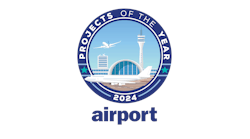An Engineer’s Perspective: UV Lighting at Airports Can Create a Safer Travel Experience
COVID-19 has been devastating to the air travel industry with major reductions in demand from travelers. Passenger confidence is still well below last year’s values. Bringing passengers back to airport terminals and regaining their confidence to fly requires a multi-faceted approach to cleaning: surface cleaning, passenger signage for social distancing, mask usage, and due to recent research discoveries of the aerosol infection nature, air purifying. Many different technologies and operational controls have been developed in response to COVID-19. Use of ultraviolet light is a key component of a total approach to infection control techniques for many of the space types within airports. It is important for aviation facility managers to understand the spaces where it can be effective, what type of ultraviolet light, and what to look for in specifying it.
Ultraviolet light (UV) comes naturally from the sun and can positively impact the human body in many ways. Given proper exposure time and intensity levels, UV light can inactivate viruses and bacteria, making them harmless to humans who later use those spaces. There’s an important distinction to emphasize: inactivation vs. killing. Product materials should be stating ability to inactivate the virus. Any materials asserting otherwise should be cause for concern and further examination.
As a part of a total risk mitigation solution including social distancing, advanced cleaning, and mask usage, all spaces and systems can benefit from using UV. No one product or method can be the silver bullet for risk elimination. Focusing on key concerns will be important. Surfaces and spaces that are needing constant cleaning and are at higher risk can be good locations to start. Specifically, airport restrooms, hold rooms, security checkpoints, and baggage claim areas can benefit from UV technology. Determining the appropriate application requires a detailed review of the infection vectors and risk models. UV light can be applied to the air stream, surfaces within the space, high-touch areas, and in the circulated airstream as an upper air application.
As a risk analysis example, security checkpoints can be extremely difficult to apply appropriate social distancing measures. Many airports only have one checkpoint for all passengers to use. The risk profile of this space is higher than areas where passengers can be separated. Cleaning cycles are also difficult to implement and can cause long delays. UV lighting in air handlers or in upper air applications, combined with increased airflow circulation rates, can be an effective means for capturing the aerosol-based particles. Using UV on security trays, belts, and baggage for constant surface cleaning can assist with larger droplets falling onto objects. The use of masks and plexiglass products help segment contamination zones and allow UV light products to focus on smaller areas.
Compared with other technologies, UV light offers several benefits to airports. The amount of existing facilities in the industry requires an easily adapted solution. UV can be retrofitted into air handlers and ceilings without extensive revisions to the structure and layout. The important constraint for application will be available power. Aside from the adaptability, UV operation can be controlled and turned off when not needed, while still being effective. An example can be turning off UV upper air lights in empty hold rooms, or surface cleaning cycles within restrooms. It can also be highly visible within the spaces and systems, which is important to consider when applying technologies. Showcasing a safe and healthy environment to passengers is key to bringing passengers back to terminals. Upper air UV can be highly visible along with applications to handrails, drinking fountains, baggage trays, and restrooms. The visibility also assists in maintenance and ensuring the technologies are operating properly while allowing for timely identification and resolution of any maintenance issues.
UV light covers a segment of wavelength in the overall light spectrum. The UV segment is from 100 to 400 nanometers. For reference, visible light is from 400 to 800 nanometers with microwaves higher and X-ray light is lower. The lower the wavelength, the more energy the light waves contain.
Within the UV segment, there are ranges that are more effective than others in combating viruses. There are four segments, UV-A (315-400 nm), UV-B (280-315 nm), UV-C (100-280 nm) and UV-Vacuum (100-200 nm). Wavelengths nearest to 265 nm are the most effective in inactivation of viruses. UV-A and UV-B are most known for the effects on human skin and aren’t as effective as UV-C. UV-C does not have the same harmful effects as UV-A and UV-B, though caution should still be exercised when around UV-C. Exposure to UV-C can cause eye pain and skin irritation, but is not known to cause skin cancer like UV-A, and UV-B. When in contact with UV-C, wearing sunglasses, pants, and long sleeve shirts should be adequate.
There are important items to look for when specifying and reviewing UV-C products and applications. The considerations are the amount of time an airstream or surface has been exposed to UV-C and the intensity of the light provided. The more time available, the lower the intensity the UV-C light can be to be effective. Some product manufacturers will claim its ineffectiveness in applications because they don’t offer appropriate intensities. Stationary surfaces, like HVAC coil cleaning, require less intense light. Moving objects like baggage conveyors should be controlled to adjust the intensity needed.
It is also important to review the wavelengths of light provided. Wavelengths outside of those mentioned can be effective for germ disinfection but may not be effective for virus inactivation. Use of terms such as disinfection, sanitization, and safe for human exposure should all raise flags for further study. Implementing products under these terms could mean a lower wavelength, lower intensity of light, and less ability to render viruses inactive.
Design and specification for retrofit into a holistic should be completed by a knowledgeable engineer that understands the impacts and needs of contact time, intensity, and power requirements. Products should be supported by third-party lab tested results supporting claims.
The role of a quality engineer cannot be understated amid current conditions as the aviation industry strives to rebound and provide the safest possible conditions for air travelers. Solutions are available and can help all airport facility managers, all while helping restore passenger confidence.
About the Author: James Dietz is the aviation practice director and associate vice president at Henderson Engineers. Dietz has a passion for the user experience and providing safe and efficient designs for air travelers. He thrives in providing solutions which balance safety, creativity, and function. Henderson is serving as the engineer-of-record and Dietz is the firm’s senior project manager for the new $1.5 billion single terminal being constructed at Kansas City International Airport (MCI). He has developed aviation design guidelines for infection control and can be reached directly at [email protected].







